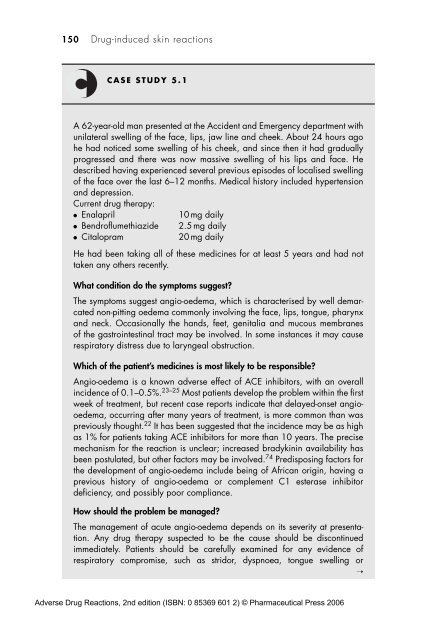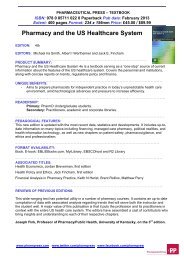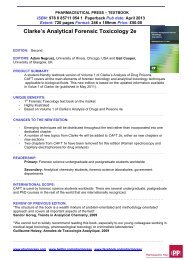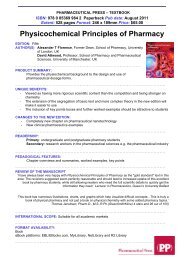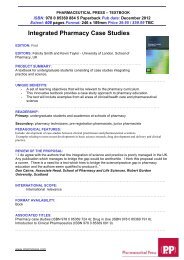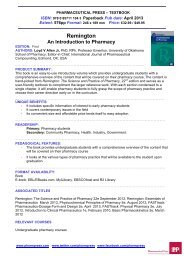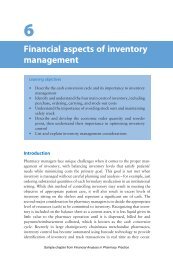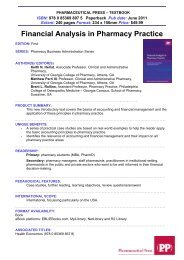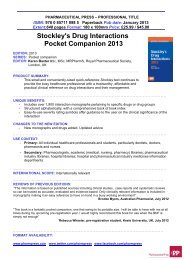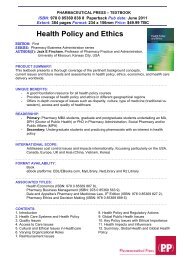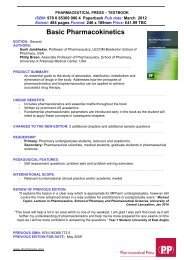Drug-induced skin reactions - Pharmaceutical Press
Drug-induced skin reactions - Pharmaceutical Press
Drug-induced skin reactions - Pharmaceutical Press
Create successful ePaper yourself
Turn your PDF publications into a flip-book with our unique Google optimized e-Paper software.
150 <strong>Drug</strong>-<strong>induced</strong> <strong>skin</strong> <strong>reactions</strong><br />
CASE STUDY 5.1<br />
A 62-year-old man presented at the Accident and Emergency department with<br />
unilateral swelling of the face, lips, jaw line and cheek. About 24 hours ago<br />
he had noticed some swelling of his cheek, and since then it had gradually<br />
progressed and there was now massive swelling of his lips and face. He<br />
described having experienced several previous episodes of localised swelling<br />
of the face over the last 6–12 months. Medical history included hypertension<br />
and depression.<br />
Current drug therapy:<br />
● Enalapril 10 mg daily<br />
● Bendroflumethiazide 2.5 mg daily<br />
● Citalopram 20 mg daily<br />
He had been taking all of these medicines for at least 5 years and had not<br />
taken any others recently.<br />
What condition do the symptoms suggest?<br />
The symptoms suggest angio-oedema, which is characterised by well demarcated<br />
non-pitting oedema commonly involving the face, lips, tongue, pharynx<br />
and neck. Occasionally the hands, feet, genitalia and mucous membranes<br />
of the gastrointestinal tract may be involved. In some instances it may cause<br />
respiratory distress due to laryngeal obstruction.<br />
Which of the patient’s medicines is most likely to be responsible?<br />
Angio-oedema is a known adverse effect of ACE inhibitors, with an overall<br />
incidence of 0.1–0.5%. 23–25 Most patients develop the problem within the first<br />
week of treatment, but recent case reports indicate that delayed-onset angiooedema,<br />
occurring after many years of treatment, is more common than was<br />
previously thought. 22 It has been suggested that the incidence may be as high<br />
as 1% for patients taking ACE inhibitors for more than 10 years. The precise<br />
mechanism for the reaction is unclear; increased bradykinin availability has<br />
been postulated, but other factors may be involved. 74 Predisposing factors for<br />
the development of angio-oedema include being of African origin, having a<br />
previous history of angio-oedema or complement C1 esterase inhibitor<br />
deficiency, and possibly poor compliance.<br />
How should the problem be managed?<br />
The management of acute angio-oedema depends on its severity at presentation.<br />
Any drug therapy suspected to be the cause should be discontinued<br />
immediately. Patients should be carefully examined for any evidence of<br />
respiratory compromise, such as stridor, dyspnoea, tongue swelling or<br />
➝<br />
Adverse <strong>Drug</strong> Reactions, 2nd edition (ISBN: 0 85369 601 2) © <strong>Pharmaceutical</strong> <strong>Press</strong> 2006


